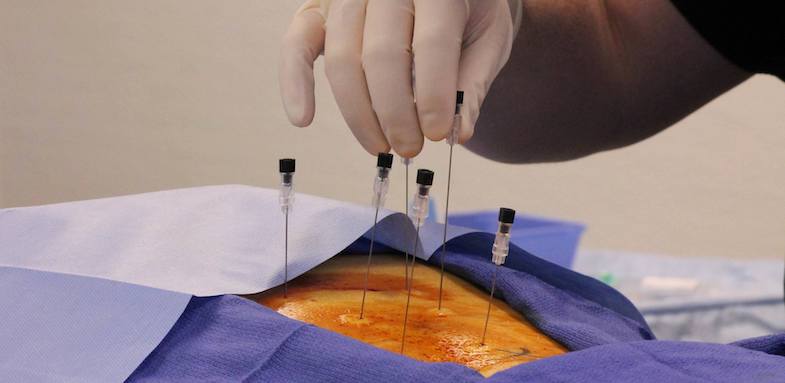Back and neck pain can impact all aspects of your life. For people suffering from chronic pain that began with acute injury, or for those who have developed age-related back or neck pain, medial branch blocks may be able to help.
Medial branch blocks are a minimally-invasive, non-surgical injection for neck and back pain.
First understanding the anatomy of your back can help you learn how these blocks work. To start, your spine consists of vertebrae cushioned by intervertebral discs that are further stabilized by facet joints. These joints allow your spine to twist and flex safely. Running through and innervating each facet joint is the medial branch of the dorsal ramus nerve – the first branching nerve root in the spine.
Over time, and sometimes because of injury or a chronic pain condition, facet joints can become irritated and inflamed. This sends pain signals from the medial nerve to your brain.
A medial branch block reduces inflammation and irritation in the facet joints of the spine, blocking these pain signals. A medial branch block placed directly next to the medial nerve may provide relief when other facet joint injections (into the joint itself) have been unsuccessful.
Medial branch blocks may also be used as a diagnostic tool. For example, patients who find relief from a medial branch block can opt for radiofrequency ablation, a more long-term pain treatment.

Medial branch blocks are often useful as a diagnostic tool. If your pain disappears with the injection, then it is clear that your pain originates from the joint.
They can also provide rapid pain relief so that patients can resume their normal daily activities. This can include physical therapy and other treatments of underlying pain conditions to support healing. Specific pain conditions that medial branch blocks may help include:
Sciatic pain (pain that radiates across the buttocks and down the hip and leg) may also find relief with a medial branch block. While sciatic pain (commonly referred to as sciatica) is itself not a specific medical condition, medial branch blocks work to alleviate pain and other symptoms so that your healthcare team can treat the underlying condition.
After making yourself comfortable on the table, your doctor will inject a long-lasting steroid and a local anesthetic like lidocaine into the area adjacent to the medial nerve that is suspected of causing your pain. The steroid reduces inflammation and irritation, and the anesthetic works to numb the pain.
To ensure proper placement of the medication, your doctor uses fluoroscopy to guide the injection.
The entire procedure usually takes less than 15 minutes. Some patients may need more than one injection for pain relief. Most patients experience pain relief that lasts up to four months per injection.
The side effects and risks of this procedure are minimal. After the injection, some patients experience minor soreness at the injection site. You can manage this with an ice pack and ibuprofen, if cleared by your doctor.
Potential complications of this procedure include bleeding, infection, and nerve damage in rare cases. Nerve damage is generally associated with misplacement of the needle, which is why proper placement of the injection is crucial.
Other risks of medial branch blocks are directly related to the medication itself, but the risk of developing medication side effects is lower than in a person taking oral corticosteroids.
Some of the potential side effects of both oral and injected corticosteroids include the following:
Be sure to discuss all potential risks (and benefits) before your procedure.
Medial branch block recovery is usually quick and easy, with most patients resuming normal activity levels after the first day or two. Any soreness from the injection is usually treated with ice packs and ibuprofen.
If you notice swelling, redness, increased pain, or fever, call your doctor. This could be a sign of infection or other side effects.
There is some evidence that the use of a medial branch block before radiofrequency ablation dramatically improves outcomes for that procedure.
Other studies have indicated that medial branch blocks can help relieve pain in the thoracic (middle back) facet joints for long periods of time.
Medial branch blocks work differently for each patient, with many finding statistically significant pain relief.
If you’re suffering from Neck and/or Back Pain, Facet Joint Syndrome contact us today to see what Regen Doctors can do for you.
